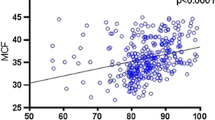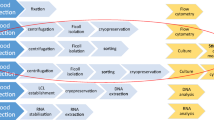Abstract
Estimation of residual leukocytes in blood components after leukodepletion is crucial for assessment of quality. Flow cytometry (FC) and Nageotte hemocytometer are the most widely accepted methods for counting residual white blood cells (rWBCs) in leucocyte-depleted (LD) blood components. The objective of this study was to compare use of Nageotte counting chamber and FC for quality control of leukodepleted red cell units. A prospective, observational study was conducted in the department of Transfusion Medicine. A total of 80 whole blood donations from healthy donors were subjected to testing by FC and Nageotte hemocytometer for estimation of rWBC in duplicate. Additionally, ten personnel attempted a survey for ease of use of FC. Number of rWBC detected by flow cytometer were between 1 WBC/μL and 28 WBCs/μL whereas that detected by Nageotte’s chamber were between 0 WBC/μL (lowest) and 5 WBCs/μL. Coefficient of variation was found to be 87.36% by Nageotte hemocytometer method and 43.26% by FC. Linear regression analysis did not show any correlation (R-squared = 0.01, p = 0.13) between the two methods which signifies that the two methods cannot be used interchangeably. Pearson’s correlation coefficient showed a weak relation between results obtained by the two methods. Inter-observer variation was found to be significant with use of Nageotte hemocytometry. Survey for ease of use of FC indicated acceptability of FC with favorable scores. Flow cytometric technique provides a reproducible and objective tool for counting rWBC in leukodepleted blood components compared with the Nageotte hemocytometer.
Similar content being viewed by others
References
Wenz B (1983) Microaggregate blood filtration and the febrile transfusion reaction: a comparative study. Transfusion 23(2):95–98
Strauss RG (1999) Leukocyte-reduction to prevent transfusion-transmitted cytomegalovirus infections. Pediatr Transplant 3:19–22
Trial to Reduce Alloimmunization to Platelets Study Group (1997) Leukocyte reduction and ultraviolet B irradiation of platelets to prevent alloimmunization and refractoriness to platelet transfusions. N Engl J Med 337(26):1861–1870
Henrichs KF, Howk N, Masel DS, Thayer M, Refaai MA, Kirkley SA, Heal JM, Blumberg N (2012) Providing ABO-identical platelets and cryoprecipitate to (almost) all patients: approach, logistics, and associated decreases in transfusion reaction and red blood cell alloimmunization incidence. Transfusion 52(3):635–640
Bassuni WY, Blajchman MA, Al-Moshary MA (2008) Why implement universal leukoreduction? Hematol/Oncol Stem Cell Ther 1(2):106–123
Dzik S (1993) Leukodepletion blood filters: filter design and mechanisms of leukocyte removal. Transfus Med Rev 7(2):65–77
Engelfriet CP, Reesink HW (1998) The use and quality control of leukocyte-depleted cell concentrates. Vox Sang 75(1):82–83
Müller TH, Döscher A, Schunter F, Scott CS (1997) Manual and automated methods for the determination of leukocyte counts at extreme low levels: comparative evaluation of the Nageotte chamber and the Abbott Cell Dyn 3500 analyser. Transfus Sci 18(4):505–515
Saran RK (2003) Transfusion medicine: technical manual, 2nd edn. Directorate General of Health Services (DGHS), New Delhi
American Association of Blood Banks (2017) AABB technical manual. American Association of Blood Banks, Bethesda
Council of Europe (2006) Guide to the preparation, use and quality assurance of blood components. Council of Europe, Strasbourg
Lee JH, Klein HG (2000) From leukocyte reduction to leukocyte transfusion: the immunological effects of transfused leukocytes. Best Pract Res Clin Haematol 13(4):585–600
Jensen LS, Anderson AJ, Christiansen PM, Hokland P, Juhl CO, Madsen G et al (1992) Postoperative infection and natural killer cell function following blood transfusion in patients undergoing elective colorectal surgery. Br J Surg 79:513–517
Acknowledgements
The authors would like to acknowledge all members of the department of Transfusion Medicine, Histocompatibility and Molecular Biology at Jaypee Hospital, Noida for participation in the study.
Funding
None.
Author information
Authors and Affiliations
Corresponding author
Ethics declarations
Conflict of interest
The authors declare no conflict of interest.
Additional information
Publisher's Note
Springer Nature remains neutral with regard to jurisdictional claims in published maps and institutional affiliations.
Rights and permissions
About this article
Cite this article
Pandey, P., Pande, A., Setya, D. et al. Comparative Study for Measurement of Residual Leucocytes in Leucodepleted Red Blood Cells by Two Different Methods. Indian J Hematol Blood Transfus 36, 740–744 (2020). https://doi.org/10.1007/s12288-020-01325-5
Received:
Accepted:
Published:
Issue Date:
DOI: https://doi.org/10.1007/s12288-020-01325-5




